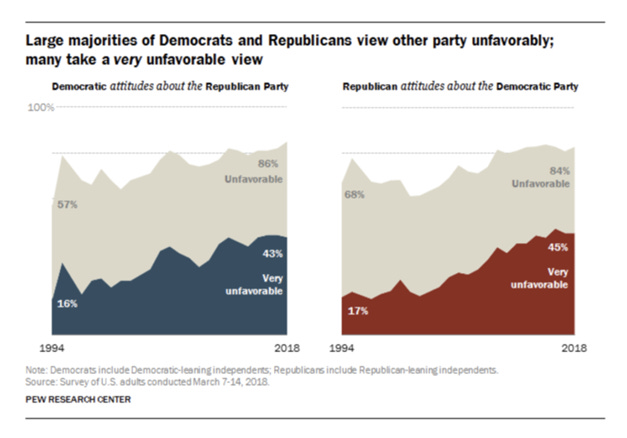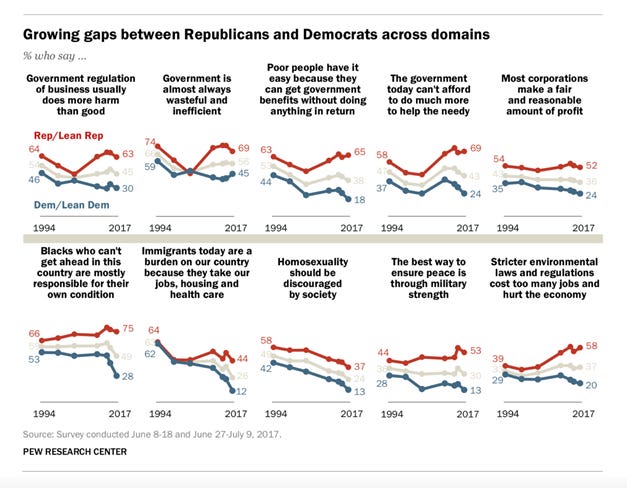The Puzzle of Polarization
How can polarization numbers be so different in the USA and Europe? And how can Europeans feel they're polarizing even if they're not?
In my home country of the Netherlands, surveys show people are concerned about growing intolerance and polarization. 75% of the Dutch believe that differences of opinion on social issues are increasing. Other European countries show similar numbers.
Interestingly, this impression that society is becoming more polarized is not caused by society actually becoming more polarized. Because, over here, it’s not. Trends in public opinion do not show that opinions have moved further apart (factual polarization). Between the opposites of the opinion spectrum there is not so much a gaping hole, but a silent consensus: a non-twittering majority that agrees with each other.
Nor have differences of opinion come to be associated with negative emotions about people who hold different views (affective polarization). On the latest surveys, the statement “There are people I have come to hate for what they believe or stand for” is getting slightly more support in 2018 (16%) than in 2012 (13%), but less than in 1970 (19%).
Contrast this European scenario with the United States, where feelings toward opposition party identifiers seem to be driven to new lows all the time. For example:
Unsurprisingly then, most scholars concur that affective polarization—“view[ing] opposing partisans negatively and copartisans positively”—appears to be increasing over there. These conclusions are often based on partisan feeling-thermometer measures. On those, participants are asked to rate how much they liked the Republican Party and the Democratic Party on a 100-point scale. Affective polarization is then calculated using the absolute value of the difference between the two scores.
Similarly, Pew data, collected over the past 25 years, shows us that the gap between the viewpoints of Democrats and Republicans has grown on issues across the board. At least, as respondents report to believe on surveys. In one study, when 419 participants who identified as Democrats or Republicans could have their name entered in a drawing for a $200 Amazon.com gift certificate for each correct answer on a survey with factual political questions, they suddenly got most things right and partisan divergence reduced by 60%. Yet if these survey responses reflected actual beliefs, then paying partisans to answer correctly should not affect their responses. Without adequate incentives, the motivation to give an answer that supports one’s political party may outweigh the motivation to give an accurate response.
That said, here is the gap from the Pew data:
This is interesting, because a common complaint in European countries is that political parties have become so similar that most voters including me are confused about who to vote for and why. Almost everyone agrees with each other so much, and compromised so readily, that supporting one party over the other seems almost pointless. For example, in 90 percent (!) of the proposed legislation, the opposition in the Netherlands agrees with the government. Even the opposition party that most often dissents, votes ‘Ai’ in eight out of ten laws. Two-thirds of the laws are even passed unanimously!
Yet, it is a fact that, here too, people feel as if social oppositions are increasing.
Why does the amount of factual polarization appear to be so different in Europe compared to the United States? And why is the sense that we’re living in a polarized country so similar nonetheless?
Social media is partly to blame
Many people point so social media as the source of all evil for why polarization is increasing (in some countries) and also for why people think it’s increasing even if it’s not (in others). For example, following the surprise victories of Brexit and Trump in 2016, even the outgoing U.S. president Barack Obama warned in his farewell speech that “it’s become safer to retreat into our own bubbles”, thereby linking increased ideological polarization with concepts such as echo chambers and filter bubbles. The idea being that technological advances in the information ecology have enabled and enhanced the propensity for self-selection into exposure to particular news media messages. If now more than ever, people are able to choose which streams of news coverage to digest, then such exposure may reinforce people’s existing preferences and attitudes, leading to increased factual polarization. Especially if, as is often said, the internet proliferates content that is emotionally outraging at significantly higher virality factors than non-polarizing content.
But this can’t be quite right. If algorithms are to blame for factual polarization, then we shouldn’t observe that other countries than the US with the same growth in internet and social media have become less polarized over the same period. Like in the Netherlands, polarization is not uniformly increasing in Western democracies. In a number of countries, it’s actually decreasing. There is no consistent trend toward more polarization in the First World! This is a strong challenge to any story linking digital media or social media or the changing media landscape to (alleged) increasing polarization.
One of the reasons for this is that the extent to which people get their information from newsfeeds populated by social and algorithmic recommendations is grossly overestimated. Only a few percent of searches on Google are about news-like matters, and just over 10% of the population considers social media to be their main news source.
In fact, counter to these concerns, research on internet users has consistently found a positive relationship between pro- and counter-attitudinal news exposure. Studies using a variety of methods haves hown that people using the internet and social media are not shielded from counter-attitudinal news. Because of this exposure to counter-attitudinal news, lo’ and behold, increased Facebook use has been found to be related to depolarization: as people were exposed to views different from their own, they developed weaker attitudes. These outcomes are in line with the observation that whatever polarization might be taking place in the United States is more apparent among older than younger adults, with the former being less likely to use social media.
Why, then, does the narrative of technology-fueled, ever-more-polarized echo chambers continue to hold sway? One reason is that polarized media consumption is much more common among an important segment of the public — the most politically active, knowledgeable, and engaged. This group is disproportionately visible online and in public life. So there might be some merit to the idea that social media contribute to the unjustified perception of increased polarization. A TV channel can attempt to portray the other side as made up of crazy extremists, but on social media, these crazy extremists are there for all to see, and it is easy to forget that they represent only a sliver of the population.
As a result, surveys show that voters from both sides of the political divide perceive both their liberal and conservative peers’ positions as more extreme than they actually are, implying inaccurate beliefs about polarization. For example, the attitudes of Democrats and Republicans on free trade are remarkably similar, being very close to the middle of the road, with a slightly more positive view for Republicans. However, Democrats are perceived as being anti–free trade (which they aren’t, on average), and Republicans as being strongly pro–free trade (which they aren’t, again on average).
Social media don’t make us more polarized, but they make us think we are. Which might contribute to affective polarization, as each side comes to dislike the other more as a result of misperceiving its views.
But maybe it’s just not all that bad
A similar loud minority kind of thing might partly be going on with affective polarization too. Many strong partisans are affectively polarized, and this can make it appear that everyone is polarized, because ideologically extreme partisans are the most politically engaged.
For what most demonstrations of affective polarization show is that the mere act of identifying with a political party is sufficient to trigger negative evaluation. But this negative evaluation might also be triggered by identifying with any political party, rather than necessarily the opposing one. For example, the book Independent Politics: How American Disdain for Parties Leads to Political Inaction reports that respondents dislike working with someone who talks about politics even when that hypothetical colleague agrees with their political views. Perhaps that what seems like negative affect toward the other party is, in fact, negative affect toward partisans from either side of the aisle and political discussion in general.
Indeed, new thermometer studies show that inparty feeling thermometer ratings have actually decreased in recent years among almost everyone who isn’t in the mentioned loud minority. In the 80s, people's average favorability rating for their own party was 72 on a 100-point scale; today it's only 63. So, in part, Americans being less positive about members of the other party is not because they have come to dislike that party specifically, but because of a dislike for partisanship in general. These data are consistent with a theory of “negative partisanship”—folks support their own party mainly because they dislike the other party—but fit less well with affective polarization.
Klar, Krupnikov and Ran (2018) also find that at least one measure of affective polarization conflates a dislike for members of the other party with a dislike for partisanship in general. The measure asks people how they feel about their child marrying someone from another party. But some respondents will assume that partisanship is an important identity for the hypothetical child-in-law if the question mentions only partisanship in describing this individual. And although some Americans are politically polarized, more simply want to avoid talking about politics. In fact, many people do not want their child to marry someone from their own party if that hypothetical in-law were to discuss politics frequently.
As politics doesn’t really matter to most people, I wonder whether non-loud-minority folks actually have the strong opinions polarization surveys ascribe to them. Especially since these opinions are largely based on their exaggerated perception of the opposing party’s loud minority, not on what most folks who vote on different politicians actually think. Which makes you wonder whether the American situation might not be so different from the European case after all. An increased perception of polarization, due to unfortunate social-media dynamics, while at the same time most of us aren’t really that polarized at all.






Excellent! I've shared it. Thanks